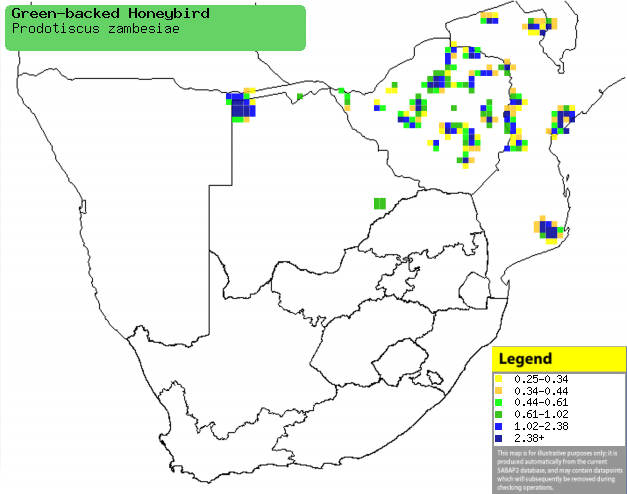|
Prodotiscus zambesiae
(Green-backed honeybird, Slender-billed honeyguide)
DunbekheuningvoŽl [Afrikaans]; Kasoro (generic term for
honeyguide/honeybird) [Kwangali]; Grijze honingspeurder [Dutch]; Indicateur gris
[French]; Zwerghoniganzeiger [German]; Indicador-de-bico-fino [Portuguese]
Life
> Eukaryotes >
Opisthokonta
> Metazoa (animals) >
Bilateria >
Deuterostomia > Chordata >
Craniata > Vertebrata (vertebrates) > Gnathostomata (jawed
vertebrates) > Teleostomi (teleost fish) > Osteichthyes (bony fish) > Class:
Sarcopterygii (lobe-finned
fish) > Stegocephalia (terrestrial
vertebrates) > Tetrapoda
(four-legged vertebrates) > Reptiliomorpha > Amniota >
Reptilia (reptiles) >
Romeriida > Diapsida > Archosauromorpha > Archosauria >
Dinosauria
(dinosaurs) > Saurischia > Theropoda (bipedal predatory dinosaurs) >
Coelurosauria > Maniraptora > Aves
(birds) >
Order: Piciformes
> Family: Indicatoridae
Distribution and habitat
It has an isolated population in Ethiopia and Kenya,
although it is most widespread further south, in the area from Angola, Zambia
and southern Tanzania to southern Africa. Within southern Africa it occurs in the Caprivi Strip (Namibia), north-western and south-eastern Botswana, Zimbabwe and
Mozambique, generally preferring Mopane (Colosphermum mopane), Zambezi
teak (Baikiaea plurijuga) and miombo (Brachystegia) woodland.
|
 |
|
Distribution of Green-backed honeybird in southern Africa,
based on statistical smoothing of the records from first SA Bird Atlas
Project (©
Animal Demography unit, University of
Cape Town; smoothing by Birgit Erni and Francesca Little). Colours range
from dark blue (most common) through to yellow (least common). |
Movements and migrations
Resident and largely sedentary, although it may
make local movements in winter.
Food
It mainly eats insects, doing most of its foraging by
plucking prey from twigs and occasionally hawking flying insects aerially. The following food items have been recorded
in its diet:
- Insects
- Fruit of mistletoes (Loranthaceae)
Breeding
- Territorial brood parasite, meaning that it lays its eggs in the nest of
other birds; the only host recorded in southern Africa is the
African yellow
white-eye, however in Zambia the
Black-throated wattle-eye,
African paradise-flycatcher,
African dusky flycatcher
and Amethyst sunbird
have all been found as hosts as well.
- Egg-laying season is from July-October, peaking from September-October.
- The female stakes out the nest of the host before laying, waiting for
the bird to leave before removing at least one of the existing eggs before
laying a single egg of its own, which is incubated by the host for about 13
days.
- The newly hatched chick uses its hooked bill to kill the other nestlings
in the first three days of its life, leaving the nest after at least 22
days.
Threats
Not threatened, although clearing of miombo (Brachystegia)
woodland in Zimbabwe is cause for concern.
References
-
Hockey PAR, Dean WRJ and Ryan PG 2005. Roberts
- Birds of southern Africa, VIIth ed. The Trustees of the John Voelcker
Bird Book Fund, Cape Town.
|
